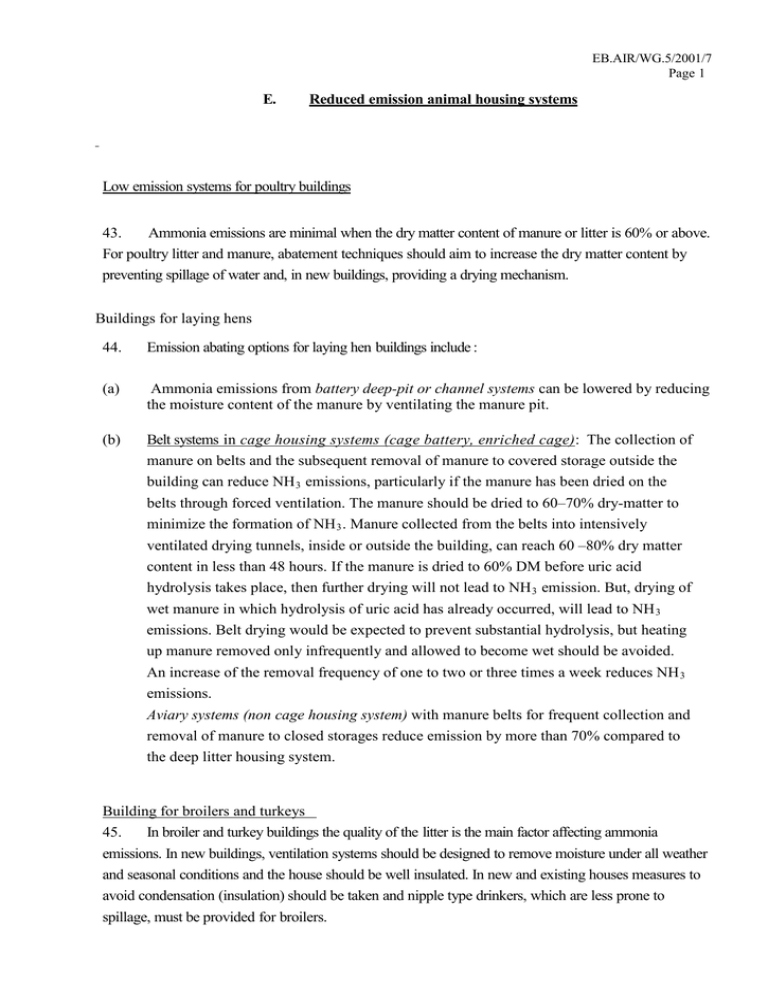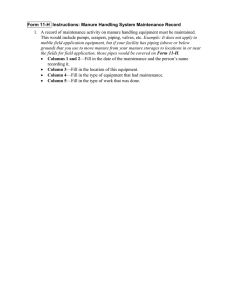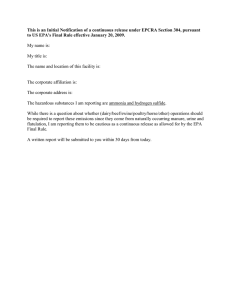Housing for Cattle and Poultry
advertisement

EB.AIR/WG.5/2001/7 Page 1 E. Reduced emission animal housing systems Low emission systems for poultry buildings 43. Ammonia emissions are minimal when the dry matter content of manure or litter is 60% or above. For poultry litter and manure, abatement techniques should aim to increase the dry matter content by preventing spillage of water and, in new buildings, providing a drying mechanism. Buildings for laying hens 44. Emission abating options for laying hen buildings include : (a) Ammonia emissions from battery deep-pit or channel systems can be lowered by reducing the moisture content of the manure by ventilating the manure pit. (b) Belt systems in cage housing systems (cage battery, enriched cage): The collection of manure on belts and the subsequent removal of manure to covered storage outside the building can reduce NH 3 emissions, particularly if the manure has been dried on the belts through forced ventilation. The manure should be dried to 60–70% dry-matter to minimize the formation of NH 3 . Manure collected from the belts into intensively ventilated drying tunnels, inside or outside the building, can reach 60 –80% dry matter content in less than 48 hours. If the manure is dried to 60% DM before uric acid hydrolysis takes place, then further drying will not lead to NH 3 emission. But, drying of wet manure in which hydrolysis of uric acid has already occurred, will lead to NH 3 emissions. Belt drying would be expected to prevent substantial hydrolysis, but heating up manure removed only infrequently and allowed to become wet should be avoided. An increase of the removal frequency of one to two or three times a week reduces NH 3 emissions. Aviary systems (non cage housing system) with manure belts for frequent collection and removal of manure to closed storages reduce emission by more than 70% compared to the deep litter housing system. Building for broilers and turkeys 45. In broiler and turkey buildings the quality of the litter is the main factor affecting ammonia emissions. In new buildings, ventilation systems should be designed to remove moisture under all weather and seasonal conditions and the house should be well insulated. In new and existing houses measures to avoid condensation (insulation) should be taken and nipple type drinkers, which are less prone to spillage, must be provided for broilers. Low emission systems for cattle buildings 47. It is difficult to reduce ammonia emissions from naturally ventilated cattle buildings. Modifying the diet, as outlined in Section 3, offers some possibilities. Systems for frequently cleaning, by scraping or flushing may be possible in some buildings. Using water for cleaning increases the volume of slurry that must be stored and managed. There is some ongoing research in the possibilities to reduce emissions from NVB through changes in the openings, application of wind shielding nets, etc. but the work is in its beginning and no recommendations are available so far. xx. Tied housing systems emit less ammonia than loose housing systems because of the reduced soiled area. Such systems are now discouraged for animal welfare, animal health and labour reasons. xx. In houses with traditional slats, optimal barn climatization with roof insulation and/or automatically controlled natural ventilation can achieve a moderate emission reduction (20%) due to the decreased temperature (especially in summer) and reduced air velocities. 48. For loose-housed cattle bedded on straw, increasing the amount of straw used per animal can reduce ammonia emissions from the building and during manure storage. The appropriate amount of straw depends on breed, feeding system, housing system and climate conditions. xx. Straw-based systems will reduce NH 3 emissions from the house compared with slurry, providing the floor space per animal is similar. xx. Good husbandry e.g. keeping passageways and yards used by cattle as clean as possible, can contribute to lower ammonia emissions on most farms. xx. The "grooved floor" system for dairy and beef cattle housing employing “toothed” scrapers running over a grooved floor turned out to be a reliable technique to abate ammonia emissions. Grooves should be equipped with perforations to allow drainage of urine. An ammonia emission reduction of 25% can be achieved relative to conventional system. EB.AIR/WG.5/2001/7 Page 3 xx. Adding acid or formalin to the flushing water improves ammonia emission abatement but is hazardous and not recommended. EB.AIR/WG.5/2001/7 Page 4


